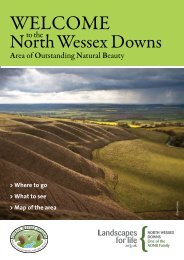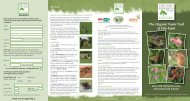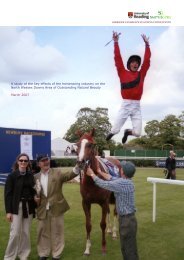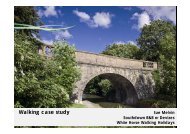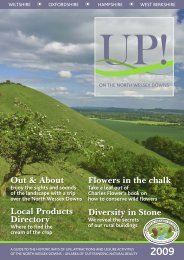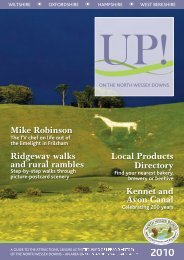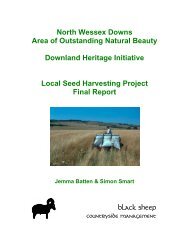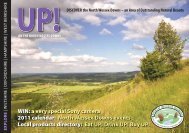International Day of Biodiversity - The North Wessex Downs
International Day of Biodiversity - The North Wessex Downs
International Day of Biodiversity - The North Wessex Downs
Create successful ePaper yourself
Turn your PDF publications into a flip-book with our unique Google optimized e-Paper software.
PR 10-01a<br />
11 May 2010<br />
For Immediate Use<br />
PRESS BRIEFING<br />
EVENTS IN THE<br />
NORTH WESSEX DOWNS AREA OF OUTSTANDING NATURAL BEAUTY<br />
MARK INTERNATIONAL DAY OF BIODIVERSITY<br />
Saturday 22 May is <strong>International</strong> <strong>Day</strong> <strong>of</strong> <strong>Biodiversity</strong>. In the <strong>North</strong> <strong>Wessex</strong><br />
<strong>Downs</strong> Area <strong>of</strong> Outstanding Natural Beauty (AONB) several events will focus<br />
on the biodiversity <strong>of</strong> these landscapes.<br />
<strong>The</strong> <strong>North</strong> <strong>Wessex</strong> <strong>Downs</strong> Area <strong>of</strong> Outstanding Natural Beauty (AONB) has unique<br />
and spectacular landscapes that include tranquil open downland, ancient woodland<br />
and chalk streams across areas <strong>of</strong> Wiltshire, Berkshire, Hampshire and Oxfordshire.<br />
Henry Oliver, acting director <strong>of</strong> the <strong>North</strong> <strong>Wessex</strong> <strong>Downs</strong> AONB, explains:<br />
“<strong>Biodiversity</strong> is a part <strong>of</strong> what makes these landscapes special. It’s not a case <strong>of</strong><br />
biodiversity or landscape. Nationally protected landscapes like AONBs are about<br />
emphasising the integration <strong>of</strong> humans and nature, not trying to separate one from<br />
the other. It presents an opportunity to understand better the relationship between<br />
people and their environment.<br />
“Here in the <strong>North</strong> <strong>Wessex</strong> <strong>Downs</strong> AONB we have one <strong>of</strong> the six remaining colonies<br />
in the UK <strong>of</strong> the Shrill Carder Bee, one <strong>of</strong> the two rarest bumblebees in the country.<br />
Marsh Fritillary and Small Blue are two rare butterflies that need the grazed<br />
downland <strong>of</strong> southern Oxfordshire to survive. Jones’s Mill Nature Reserve at Pewsey<br />
with marsh grasses, flowers and woods is the only fenland nature reserve in<br />
Wiltshire. Desmoulin’s Whorl Snail is an endangered species and lives in the valleys<br />
<strong>of</strong> West Berkshire and Wiltshire.”<br />
To mark <strong>International</strong> <strong>Day</strong> <strong>of</strong> <strong>Biodiversity</strong> the <strong>North</strong> <strong>Wessex</strong> <strong>Downs</strong> AONB is<br />
launching the <strong>North</strong> <strong>Wessex</strong> <strong>Downs</strong> Parish Wildlife Map Toolkit. This enables<br />
people to identify and survey biodiversity and create a parish wildlife map <strong>of</strong> the key<br />
habitats and species within their parish, town or village boundary.<br />
<strong>The</strong> <strong>North</strong> <strong>Wessex</strong> <strong>Downs</strong> AONB is <strong>of</strong>fering support to communities in the area who<br />
would like to pilot this toolkit. Hampshire & Isle <strong>of</strong> Wight Wildlife Trust produced the<br />
<strong>North</strong> <strong>Wessex</strong> <strong>Downs</strong> Parish Wildlife Map Toolkit with funding from the AONB’s<br />
Sustainable Development Fund, Basingstoke and Deane Borough Council and<br />
Hampshire County Council.
<strong>International</strong> <strong>Day</strong> <strong>of</strong> <strong>Biodiversity</strong> events [full details below]<br />
Oxfordshire/West Berkshire border<br />
Bat & Moth Night, 15 May<br />
Celebrate National Moth Night at Sheepdrove Organic Farm, Lambourn. This is a<br />
chance to discover moths and bats at the Farm’s herb gardens and reed beds where<br />
seven types <strong>of</strong> bats have been recorded including the largest species – Noctule and<br />
Serotine – who love to eat moths!<br />
Hampshire<br />
Spring Flying Insects at Old Burghclere Lime Quarry, 19 May<br />
A very leisurely walk to identify butterflies other flying insects and flora, organised by<br />
Hampshire & Isle <strong>of</strong> Wight Wildlife Trust.<br />
Wiltshire<br />
Jones’s Mill Conservation Volunteers, Pewsey, 22 May<br />
Volunteers will be working on this Site <strong>of</strong> Special Scientific Interest and the county’s<br />
only fenland nature reserve just east <strong>of</strong> Pewsey.<br />
West Berkshire<br />
Lambourn Valley Barn Owl Group, 15 May<br />
A practical session to create habitats for barn owls.<br />
Lambourn Stones and Horses, 23 May<br />
<strong>The</strong> Friends <strong>of</strong> Pang, Kennet and Lambourn Valleys and Berkshire RIGS group<br />
guided walk around Lambourn to learn about the geology, history and wildlife as well<br />
as racehorses.<br />
<strong>Biodiversity</strong> for children, Hungerford Farmers' Market, 23 May<br />
Hungerford Environmental Action Team (HEAT) hosts child-friendly biodiversity<br />
activities at their stall.<br />
ENDS<br />
For more information about the <strong>North</strong> <strong>Wessex</strong> <strong>Downs</strong> AONB:<br />
Oliver Cripps, Acting Assistant Director 01488 680457 (<strong>of</strong>fice)<br />
07827 082382 (mobile)<br />
<strong>North</strong> <strong>Wessex</strong> <strong>Downs</strong> AONB Office 01499 685440 (switchboard)<br />
*****************************************************************************<br />
Details <strong>of</strong> the events listed above<br />
Bat & Moth Night, 15 May<br />
Celebrate National Moth Night at Sheepdrove Organic Farm, Lambourn. Discover<br />
moths and bats at the Farm’s herb gardens and reed beds where seven types <strong>of</strong> bats<br />
have been recorded including the largest species – Noctule and Serotine – who love<br />
to eat moths! Admission is free but you must book a place. <strong>The</strong> event begins at 8pm<br />
with an introduction to bats and moths, and as the sun sets the bat detectors should<br />
start picking up the clicks, buzzes and pops <strong>of</strong> the farm’s bats! All welcome, children<br />
must be supervised at all times. Sorry, no dogs permitted.<br />
Further information Jason Ball: 01488 674727 to book your place.<br />
Spring Flying Insects at Old Burghclere Lime Quarry 19 May
Old Burghclere, Hampshire<br />
A very leisurely walk, organised by the Hampshire Wildlife Trust and led by Mervyn<br />
Grist and Graham Dennis, to learn to identify the butterflies, other flying insects and<br />
flora in this sheltered quarry reserve. We will also see what's in a moth trap. Bring<br />
your camera and perhaps packed lunch for a longer stay. Meet and park at the<br />
former station yard at Old Burghclere (Map ref. SU 469 578). Detailed directions -<br />
about 6km south <strong>of</strong> Newbury, turn <strong>of</strong>f old A34 (which runs parallel to the new dual<br />
carriageway) towards Kingsclere. After 1km go round sharp right bend and at the<br />
next sharp left bend, go straight on down a lane. <strong>The</strong> car park is in the farmyard<br />
about 200m on the left. Suggested donation £1.50. Sorry, no dogs.<br />
Further information, Mervyn Grist: 01264 358737.<br />
Jones's Mill Conservation Volunteers 22 May<br />
Pewsey, Wiltshire<br />
Help the volunteers to preserve this very special SSSI habitat through tasks varying<br />
from ride clearance and vegetation removal to boardwalk construction. Jones’s Mill is<br />
an area <strong>of</strong> fen vegetation, scrub and woodland lying along the headwaters <strong>of</strong> the<br />
Salisbury Avon north east <strong>of</strong> Pewsey. It represents the best-known example <strong>of</strong> a<br />
calcareous valley mire in Wiltshire. <strong>The</strong> site occupies a shallow valley and much was<br />
formerly managed as water meadow with some watercress beds. <strong>The</strong> pattern <strong>of</strong><br />
vegetation is complex with an intimate mixture <strong>of</strong> fen, willow-scrub and willow and<br />
alder carr. An area <strong>of</strong> woodland planted with native and exotic broadleaves and<br />
conifers adds to the diversity <strong>of</strong> habitats.Take the Burbage road from Pewsey. Turn<br />
left down Dursden Lane, just before a white cottage. Park in the small lay-by, just<br />
over the railway bridge; grid ref SU 169 612.<br />
Further information, Jane Brown: 01672 569241<br />
Lambourn Valley Barn Owl Group 15 May<br />
A session <strong>of</strong> practical Barn Owl conservation work,10am – 1pm.<br />
Further information Jason Ball: 01488 674727.<br />
Lambourn - Stones and Horses RIGS Walk (Friends <strong>of</strong> the Pang Kennet and<br />
Lambourn Valleys Countryside Project / Berkshire RIGS) 23 May<br />
Lambourn, West Berkshire<br />
A joint 'Friends' and Berkshire Geoconservation (RIGS) walk to look at the geology,<br />
history and wildlife around Lambourn. Racehorses will feature strongly! Meet Lesley<br />
Dunlop and Dick Greenaway at Lambourn church (Grid ref: SU 326 790) and bring a<br />
packed lunch. <strong>The</strong>re is an optional short cut home on this walk avoiding one <strong>of</strong> the<br />
two steep hills. Walk lengths 5 miles or 3.5 miles.<br />
Further information, Project Office: 0118 930 5336.<br />
<strong>Biodiversity</strong> Activities with HEAT 23 May<br />
Hungerford Farmers’ Market, Hungerford<br />
<strong>The</strong> Hungerford Environmental Action Team will be holding various child-friendly<br />
biodiversity activities at their stall.<br />
Further information, Corinna Woodall <strong>of</strong> the Landscape and <strong>Biodiversity</strong> Group<br />
01488 680456<br />
Examples <strong>of</strong> biodiversity in the <strong>North</strong> <strong>Wessex</strong> <strong>Downs</strong><br />
Shrill Carder Bee<br />
<strong>The</strong> Bumblebee Habitat Project is working throughout southern England and Wales<br />
to help conserve the Shrill Carder Bee (Bombus sylvarum), one <strong>of</strong> the two rarest
umblebees in the UK. Bumblebees are key pollinators for the majority <strong>of</strong> our crops<br />
and wildflowers, so it is imperative that we look after them. With a grant from the<br />
<strong>North</strong> <strong>Wessex</strong> <strong>Downs</strong> AONB Sustainable Development Fund, the Bumblebee<br />
Conservation Trust produced a leaflet to inform the farmers and land managers<br />
about managing habitats for the Shrill Carder Bee. For more information and<br />
opportunities for habitat maintenance and restoration contact Dr Pippa Rayner <strong>of</strong> the<br />
Bumblebee Conservation Trust on 07792 136928, or pippa.rayner@stir.ac.uk.<br />
Marsh Fritillary and Small Blue butterflies<br />
<strong>The</strong>se are two high priority species in the UK <strong>Biodiversity</strong> Action Plan. Sheepdrove<br />
Farm near Lambourn on the boundaries <strong>of</strong> Oxfordshire and Berkshire has a<br />
conservation project to create the habitats with Devil’s Bit Scabious flowers and<br />
grazed downland in which these butterflies will breed. Sheepdrove Conservation<br />
Volunteers are working on a Butterfly Bank to support the butterflies and their<br />
caterpillars. Further information, Jason Ball: 01488 674727<br />
Desmoulin’s Whorl Snail<br />
This tiny and endangered snail lives in the valleys <strong>of</strong> the River Kennet and its<br />
tributaries in West Berkshire. It may be found on the Elm Farm Wildlife Trail at<br />
Hamstead Marshall.<br />
<strong>The</strong> Organic Research Centre at Elm Farm has produced a range <strong>of</strong> materials,<br />
supported by the <strong>North</strong> <strong>Wessex</strong> <strong>Downs</strong> AONB Sustainable Development Fund, to<br />
publicise its interactive farm trail. Aimed at both adults and children, the leaflets and<br />
interpretation boards are designed to stimulate an interest in the wildlife features that<br />
can be found around a working farm. <strong>The</strong> trail is a permissive path, open to the public<br />
throughout the year. Further information, contact Bob Winfield at Elm Farm: 01488<br />
658298.<br />
<strong>The</strong> <strong>North</strong> <strong>Wessex</strong> <strong>Downs</strong> Parish Wildlife Map Toolkit<br />
Further information, contact Oliver Cripps olivercripps@northwessexdowns.org.uk or<br />
01488 680457, or Liz Allinson, Hampshire & Isle <strong>of</strong> Wight Wildlife Trust, 01256<br />
381190.<br />
Editors’ Notes<br />
<strong>The</strong> <strong>North</strong> <strong>Wessex</strong> <strong>Downs</strong> Area <strong>of</strong> Outstanding Natural Beauty covers 1,730 sq<br />
km (668 sq miles) and is the largest AONB in southern England. It was created in<br />
1972 to give a protective coherence to one <strong>of</strong> the largest tracts <strong>of</strong> chalk downland in<br />
southern England which is least affected by development. <strong>The</strong> purpose <strong>of</strong> AONBs is<br />
to conserve and enhance the natural beauty <strong>of</strong> the landscape. Together with National<br />
Parks, AONB enjoy the highest level <strong>of</strong> protection. <strong>The</strong> <strong>North</strong> <strong>Wessex</strong> <strong>Downs</strong> AONB<br />
<strong>of</strong>fice at Denford Manor, Hungerford was set up in October 2002.<br />
www.northwessexdowns.org.uk 01488 685440.<br />
National Association <strong>of</strong> Areas <strong>of</strong> Outstanding Natural Beauty<br />
1. 2010 marks the <strong>International</strong> Year <strong>of</strong> <strong>Biodiversity</strong> (IYB).<br />
2. <strong>The</strong> family <strong>of</strong> AONBs including the <strong>North</strong> <strong>Wessex</strong> <strong>Downs</strong> AONB is supporting the<br />
IYB with a series <strong>of</strong> events, talks and publications throughout the year. See<br />
www.biodiversityislife.net for further information.<br />
3. <strong>The</strong>re are 47 AONBs in the UK. <strong>The</strong>ir primary purpose is:<br />
• To conserve and enhance the natural beauty <strong>of</strong> the landscape.<br />
Two secondary aims complement the primary purpose and should be undertaken<br />
without conflicting with the primary purpose:
• To have regard for the interest <strong>of</strong> those who live and work there.<br />
• To meet the need for quiet enjoyment <strong>of</strong> the countryside.<br />
4. AONBs are designated by Natural England (England), the Countryside Council<br />
for Wales (Wales) and <strong>North</strong>ern Ireland Environment Agency (<strong>North</strong>ern Ireland).<br />
5. AONBs are cared for by dedicated pr<strong>of</strong>essional teams working with local partner<br />
organisations to implement a statutory management plan.<br />
6. <strong>The</strong> National Association for AONBs (NAAONB) is an independent organisation<br />
acting on behalf <strong>of</strong> the 47 AONBs in England, <strong>North</strong>ern Ireland and<br />
Wales. Further information about AONBs: www.aonb.org.uk 01451 862007 or<br />
01451 862035.<br />
Press release distributed by<br />
Wendy Tobitt, PR for <strong>North</strong> <strong>Wessex</strong> <strong>Downs</strong> AONB,<br />
07748 641452. wendy.tobitt@btinternet.com




